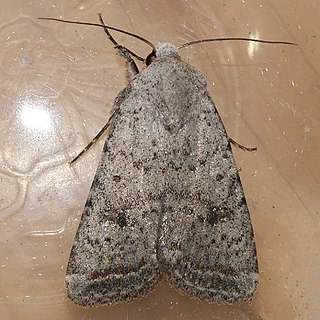
The Caradrinini are a mid-sized tribe of moths in the family Noctuidae.

Caradrina clavipalpis, the pale mottled willow, is a moth of the family Noctuidae. The species was first described by Giovanni Antonio Scopoli in his 1763 Entomologia Carniolica. It is found in the Palearctic realm. It is an introduced species in North America, where it was first reported from Queens in New York City in 1993. In 2009 it was found in Rochester, New York, so it appears to be established and spreading.

Caradrina kadenii, or Clancy's rustic, is a moth of the family Noctuidae. The species was first described by Christian Friedrich Freyer in 1836. It originates from southern and central Europe, Asia Minor and southern Russia but in the 21st century it has extended its range to the north.
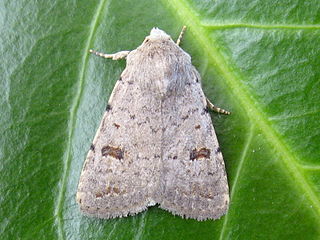
Caradrina is a genus of moths of the family Noctuidae. The genus was erected by Ferdinand Ochsenheimer in 1816. It is divided into eight subgenera, including Paradrina and Platyperigea, which are treated as separate genera by some authors.

Caradrina gilva is a moth of the family Noctuidae. It is endemic to southern Central Europe.The eastern distribution extends to the Middle East up to Turkey. In the Alps it reaches heights of about 1600 meters.Isolated records in other regions indicate that the species is sometimes migratory and it has recently been expanding its range. The first sighting in Spain was in 2007 and in The Netherlands June 1, 2009 in Geulle.The main habitat is warm, rocky mountain slopes, occasionally also grassy areas.
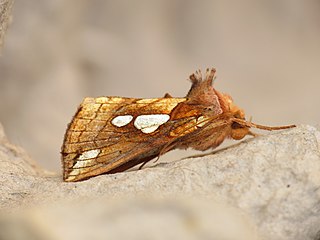
Plusia putnami, the Lempke's gold spot or Putnam's looper moth, is a species of moth of the family Noctuidae. It is found in the Palearctic realm, from Japan and eastern Siberia to Fennoscandia, Great Britain, and France. In North America, it ranges from Newfoundland and Labrador to central Alaska and the interior of British Columbia, south to Pennsylvania, Washington, north-eastern California, and in the Rocky Mountains to Utah and Colorado.
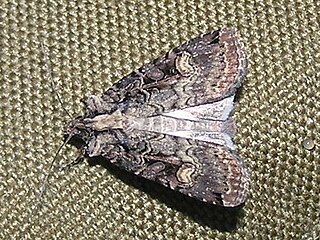
Opigena polygona is a moth of the family Noctuidae. It is found from the Netherlands, Sweden and Finland, through central and south-eastern Europe to central Asia, northern Iran, the Caucasus, Transcaucasia, Armenia, Turkey, Irkutsk, western and central China, Tibet, Nepal and northern India.

Caradrina multifera, the speckled rustic moth, is a moth of the family Noctuidae. The species was first described by Francis Walker in 1857. It is found in North America from Newfoundland to North Carolina and Tennessee and west to Minnesota and Manitoba. It is also present in British Columbia and Washington.
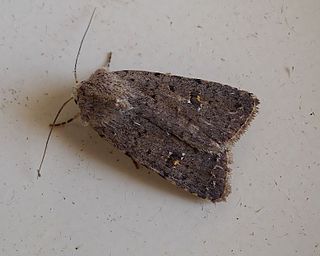
Caradrina flavirena is a moth of the family Noctuidae. It was described by Achille Guenée in 1852. It is found in Morocco, Algeria, southern Europe, Turkey, Israel, Lebanon, Jordan, Syria, Armenia and Iran. The habitat consists of grasslands.
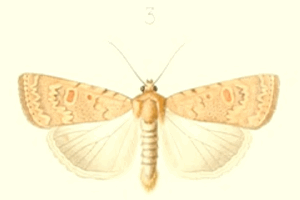
Caradrina flava is a moth of the family Noctuidae. It was described by Charles Oberthür in 1876. It is found in Spain and Greece and on Malta and the Canary Islands, as well as from the Sahara to the Arabian Peninsula, Israel, Jordan, the Levant, Iran and Iraq.

Caradrina selini is a moth of the family Noctuidae. It was described by Jean Baptiste Boisduval in 1840. It is found in most of Europe, North Africa and the Near East.
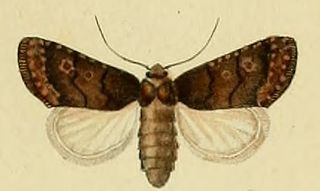
Caradrina germainii is a moth of the family Noctuidae. It was described by Philogène Auguste Joseph Duponchel in 1835. It is found in south-western Europe and North Africa. It is found mostly in garigue habitats.

Mniotype adusta, the dark brocade, is a moth of the family Noctuidae. It was described by Eugenius Johann Christoph Esper in 1790. It is found throughout much of the Palearctic from Europe to Japan, China and Mongolia. It is also found in North America. The habitat consists of heathland, chalky downland, fenland, moorland and upland areas.

Lacinipolia vicina is a moth in the family Noctuidae. It is found in Massachusetts, New York, Pennsylvania, Virginia, North Carolina, New Jersey and possibly Indiana.
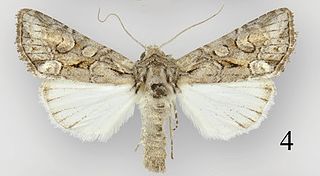
Lacinipolia teligera is a moth in the family Noctuidae. It is found from the Great Plains of central Colorado and eastern Kansas southward to central Texas.
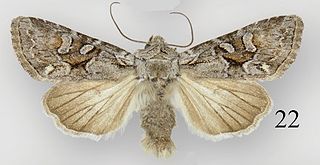
Lacinipolia pensilis is a moth in the family Noctuidae. It is found in the western cordilleran region from central British Columbia and western Alberta southward to at least Washington and central Utah.

Lacinipolia acutipennis is a moth in the family Noctuidae. It is common throughout xeric, low elevation habitats of western North America. The core range includes the dry, western portions of the Great Plains, the Great Basin, and the western intermontane valleys north of the Sonoran zone, from southern Saskatchewan and Alberta southward to northern Arizona and New Mexico.

Lacinipolia sareta is a moth in the family Noctuidae. It is found throughout western North America, from the southern Yukon and the Northwest Territories to Texas, Arizona and California. It probably also occurs in northern Mexico. It ranges eastward across the southern boreal region to at least Quebec.
Caradrina petraea is a moth belonging to the family Noctuidae. The species was first described by Johan Martin Jakob von Tengström in 1869.
Caradrina albina is a species of moth belonging to the family Noctuidae.

















